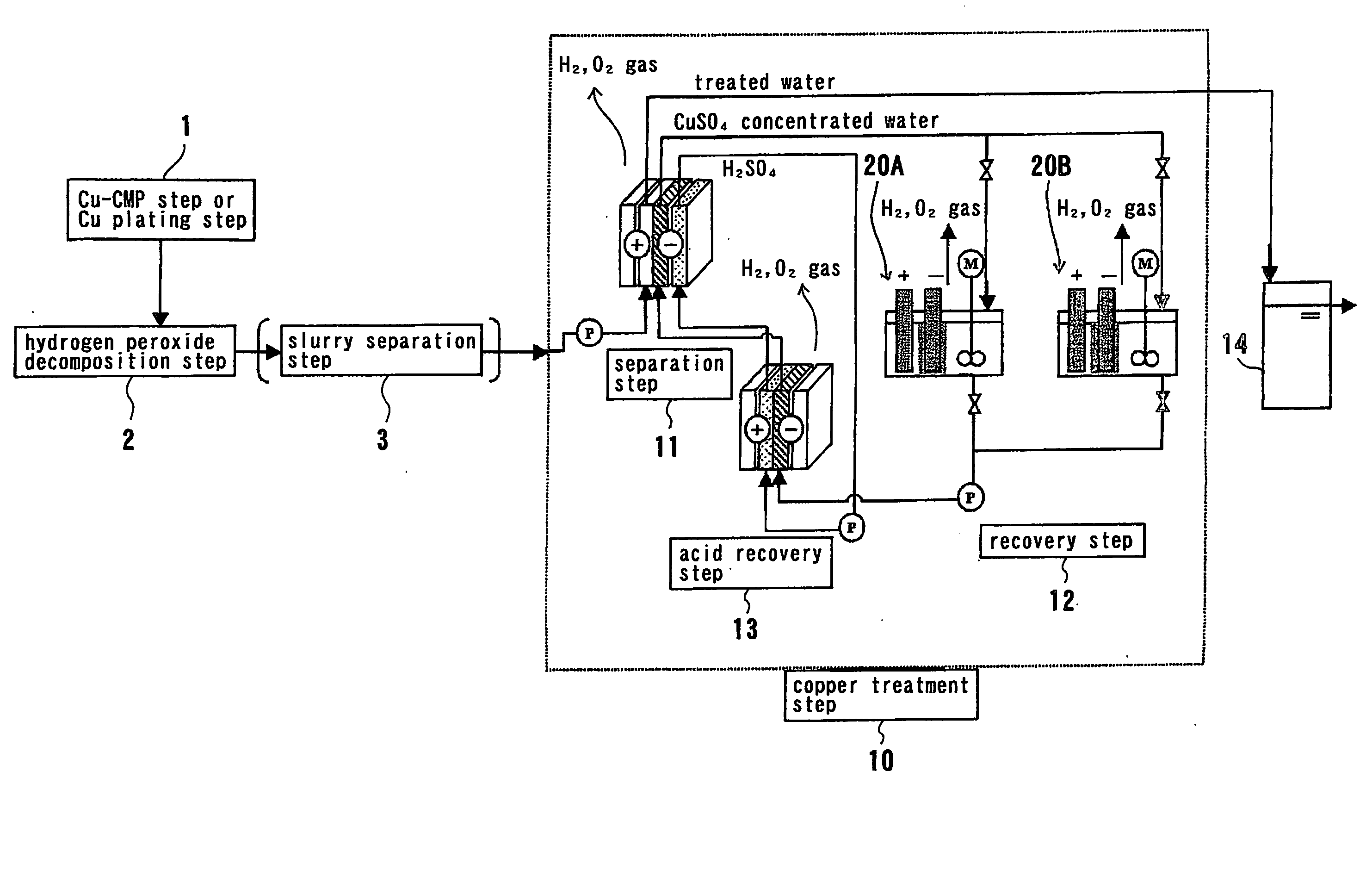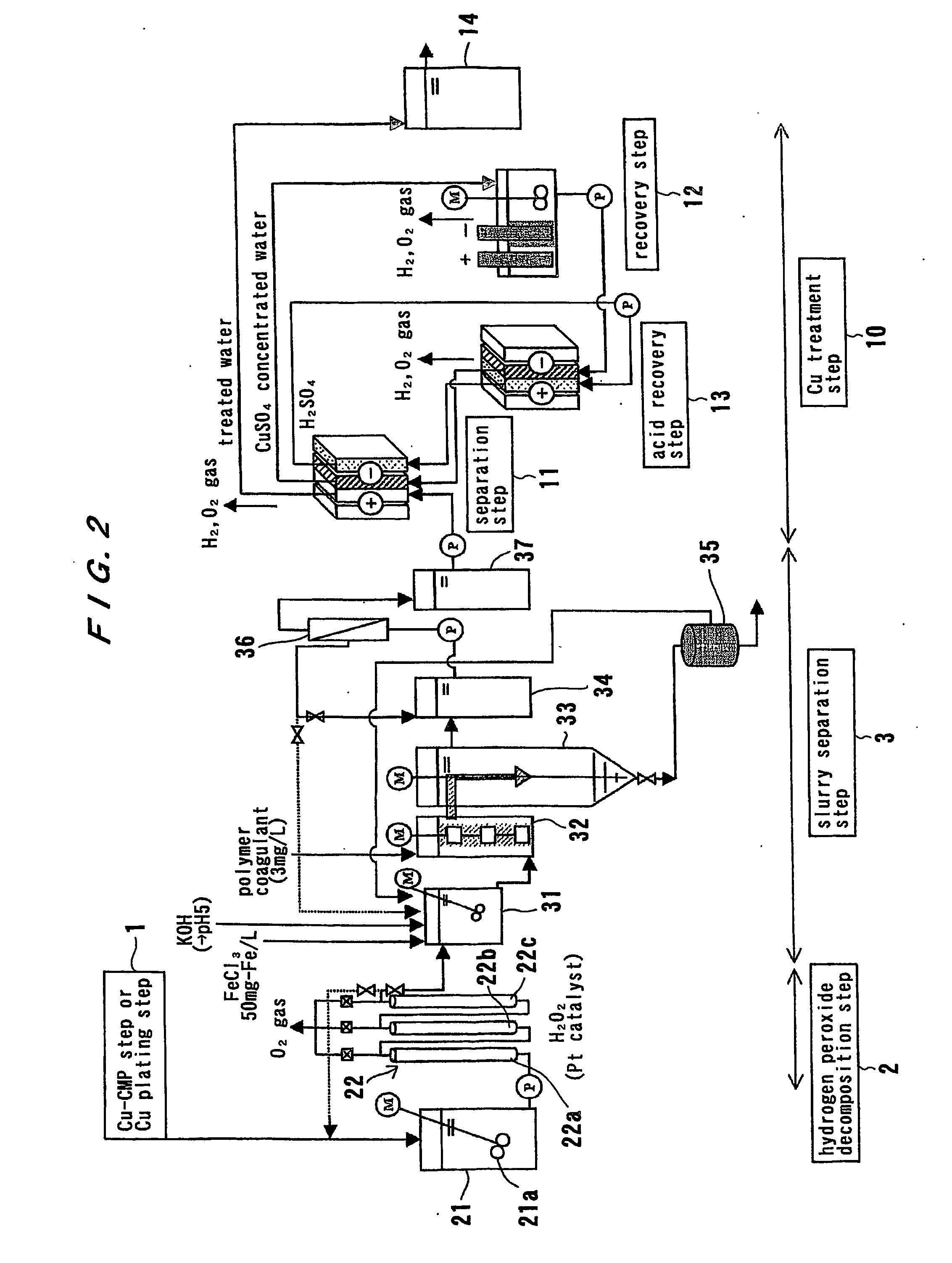Method and apparatus for treating waste water
a technology for treating waste water and waste water, applied in water/sewage treatment by neutralisation, electrodialysis, water/sewage treatment by ion exchange, etc., can solve the problems of interconnection resistance, difficult to etch a copper layer in a semiconductor, signal delay due to interconnection resistance, etc., to achieve good gas separation, increase the decomposition rate, and the effect of large specific surface area
- Summary
- Abstract
- Description
- Claims
- Application Information
AI Technical Summary
Benefits of technology
Problems solved by technology
Method used
Image
Examples
example 1
[0193] In this example, nonwoven fabric having the following characteristics was used as a base material for producing a cation-exchange nonwoven fabric. The base nonwoven fabric was formed by thermal fusion of composite fiber which consists of a core portion of polypropylene and a sheath portion of polyethylene.
TABLE 1Component of corePolypropyleneComponent of sheathPolyethyleneAreal density50 g / m2Thickness0.55 mmDiameter of fiber15-40 μmProducing method of nonwoven fabricthermal fusionPorosity91%
[0194] A gamma ray was irradiated to the nonwoven fabric substrates under a nitrogen atmosphere and then immersed into a solution of glycidyl methacrylate (GMA). Thus, the nonwoven fabric substrates were reacted with the solution to form graft-polymerized nonwoven fabric having a graft ratio of 175%. The graft-polymerized nonwoven fabric was immersed into a mixed solution of sodium sulfite, isopropyl alcohol, and water, for sulfonation. Thus, a cation-exchange nonwoven fabric was produce...
example 2
[0195] Experiment was carried out using the experimental apparatus shown in FIG. 22. In FIG. 22, the reference numeral 134 denotes a cation-exchange membrane, 136 denotes treated water, 138 denotes concentrated water, 141 denotes an electrolytic deposition apparatus, and 142 denotes water to be treated. In the separation treatment, the cation-exchange nonwoven fabric having sulfo group was used as an ion exchanger in the desalting chamber 135, and the cation-exchange nonwoven fabric having sulfo group was used as an ion exchanger in the concentrating chamber 137. As electrode material, the cathode 140 was made of expanded metal (material: SUS), and the anode 139 was made of expanded metal (material: titanium coated with platinum). Sulfuric acid was supplied to the cathode chamber so that a pH of the liquid became 1.5 or less.
[0196] In the recovery of copper, plate-like electrodes were employed. The anode material was titanium coated with platinum, and the cathode material was coppe...
example 3
[0201] Slurry-suspended Cu-CMP waste water (TS: 2500 mg / l, Cu concentration: 100 mg / l, H2O2 concentration: 1000 mg / l, ζ potential of slurry: minus (negative) value (−20 mV or less) in a pH of 3 to 10 although the ζ potential varies depending upon pH) was adjusted to a pH of 5 by the addition of sulfuric acid, and then hydrogen peroxide in the waste water is decomposed in a hydrogen peroxide decomposition apparatus shown in FIG. 3. A catalyst-packed tower having a three-column structure was used. A gas-liquid separator was provided between adjacent columns to remove an oxygen gas generated by the decomposition of hydrogen peroxide.
[0202] The treatment was carried out under conditions of water flowing speed 30 m / hour and contact time 3 minutes (in total of three columns). The catalyst used was a platinum-coated metal honeycomb catalyst (having an acid-resistant coating), and had a pore density of 500 cell / square inch. The amount of platinum coated by the metal honeycomb catalyst was ...
PUM
| Property | Measurement | Unit |
|---|---|---|
| width | aaaaa | aaaaa |
| concentration | aaaaa | aaaaa |
| concentration | aaaaa | aaaaa |
Abstract
Description
Claims
Application Information
 Login to View More
Login to View More - R&D
- Intellectual Property
- Life Sciences
- Materials
- Tech Scout
- Unparalleled Data Quality
- Higher Quality Content
- 60% Fewer Hallucinations
Browse by: Latest US Patents, China's latest patents, Technical Efficacy Thesaurus, Application Domain, Technology Topic, Popular Technical Reports.
© 2025 PatSnap. All rights reserved.Legal|Privacy policy|Modern Slavery Act Transparency Statement|Sitemap|About US| Contact US: help@patsnap.com



